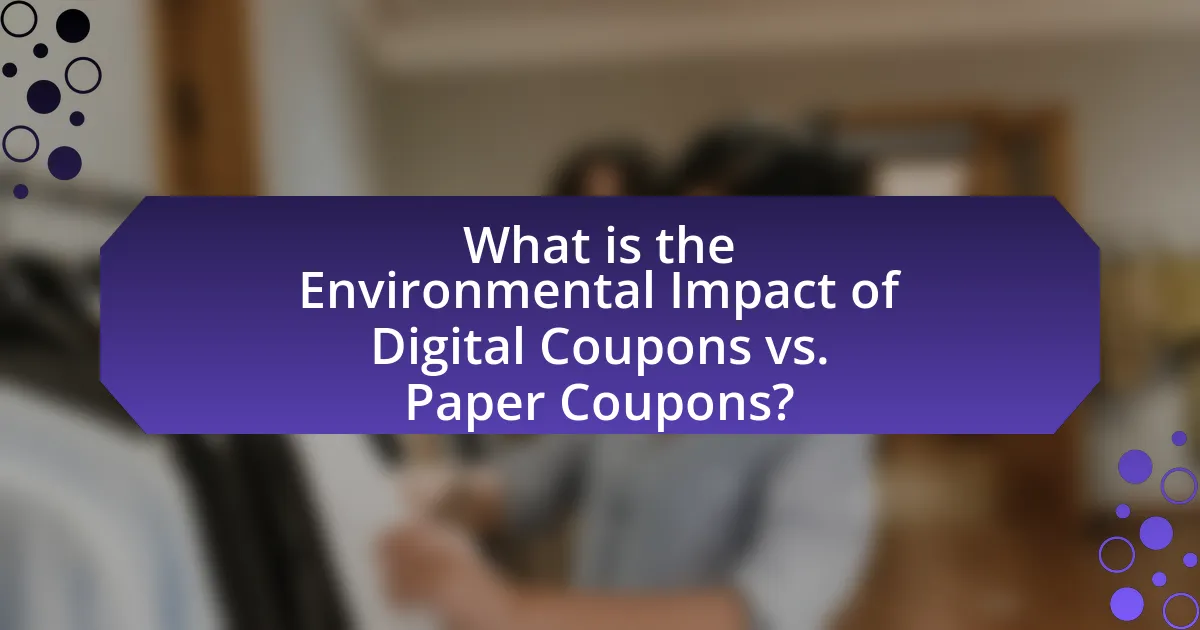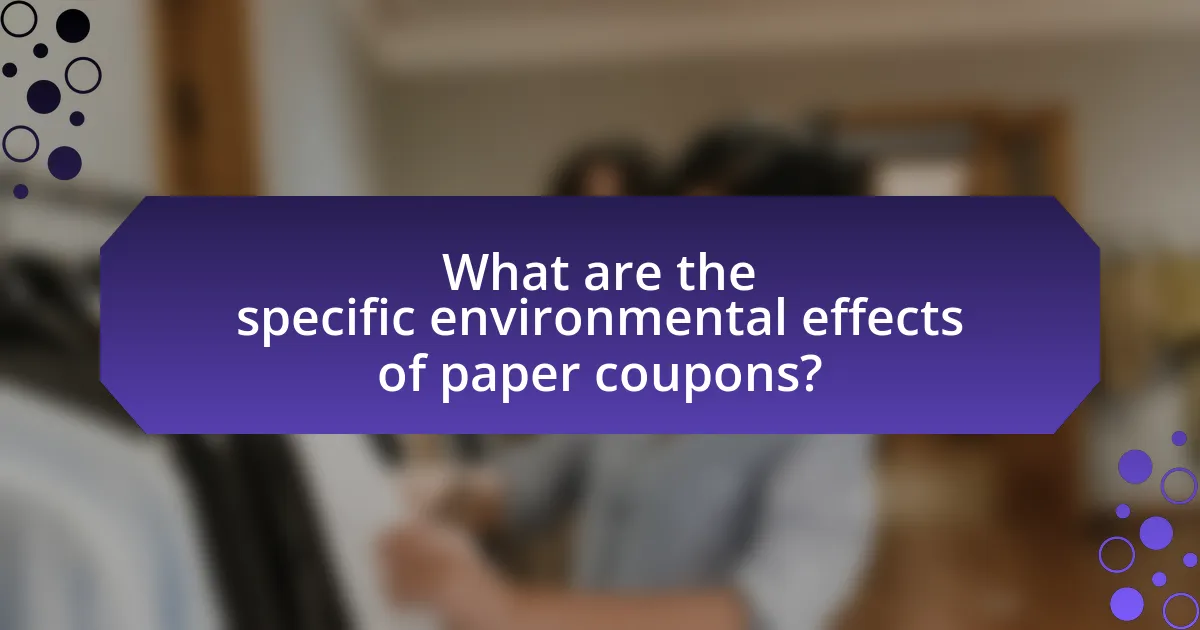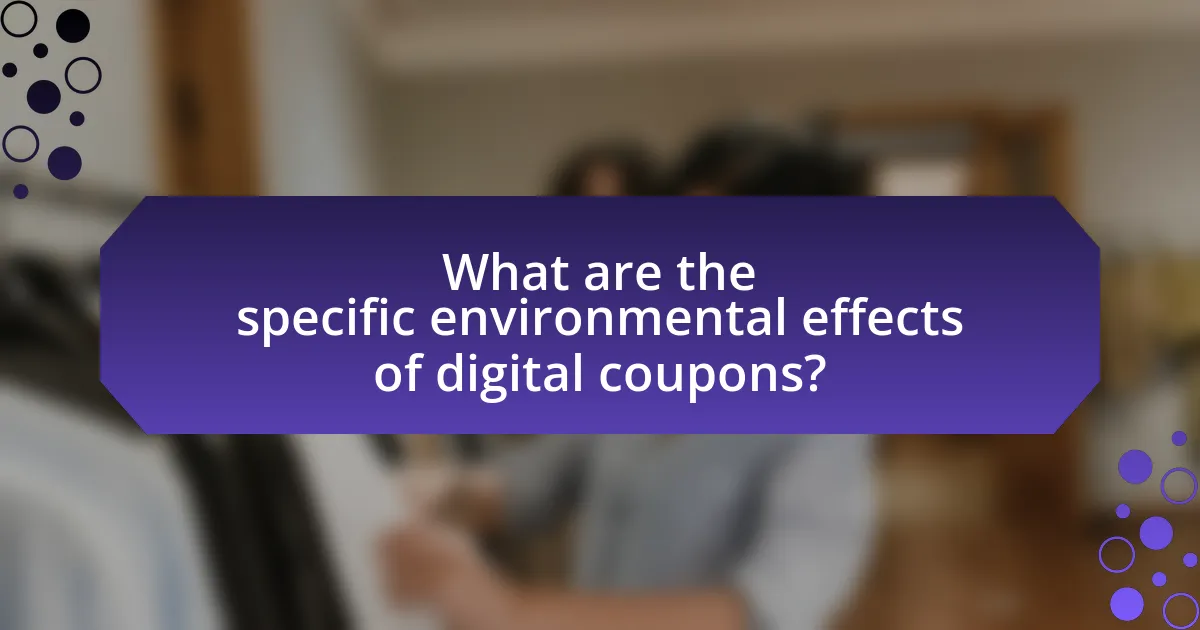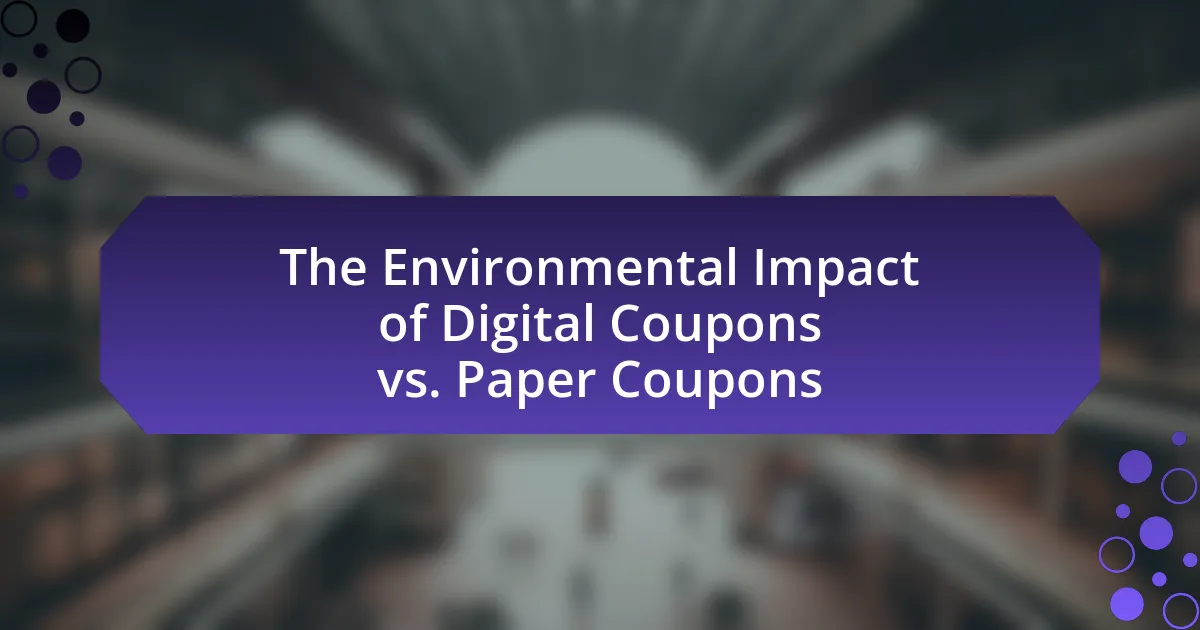The article examines the environmental impact of digital coupons compared to paper coupons, highlighting the significant advantages of digital formats in reducing resource consumption and waste. It details the resource-intensive production processes of paper coupons, which contribute to deforestation, carbon emissions, and landfill waste, while emphasizing that digital coupons minimize these environmental burdens. The discussion includes the energy requirements for both coupon types, the implications of consumer behavior on sustainability, and the challenges associated with electronic waste from digital coupon usage. Overall, the article underscores the importance of transitioning to digital coupons for a more sustainable future in couponing practices.

What is the Environmental Impact of Digital Coupons vs. Paper Coupons?
Digital coupons have a significantly lower environmental impact compared to paper coupons. The production of paper coupons involves deforestation, water consumption, and energy use, contributing to carbon emissions. In contrast, digital coupons eliminate the need for physical materials, reducing waste and resource consumption. A study by the Environmental Paper Network indicates that producing one ton of paper generates approximately 2,600 pounds of carbon dioxide, while digital transactions require minimal energy for data storage and transmission. Therefore, the shift from paper to digital coupons represents a more sustainable choice for consumers and retailers alike.
How do digital coupons differ from paper coupons in terms of environmental impact?
Digital coupons have a significantly lower environmental impact compared to paper coupons. The production of paper coupons involves deforestation, water consumption, and energy use, contributing to carbon emissions and waste. In contrast, digital coupons eliminate the need for physical materials, reducing paper waste and the associated environmental footprint. According to a study by the Environmental Paper Network, producing one ton of paper requires approximately 24,000 gallons of water and results in 1.5 tons of carbon emissions. Therefore, the shift to digital coupons not only conserves resources but also minimizes pollution and waste, making them a more sustainable option.
What resources are consumed in the production of paper coupons?
The production of paper coupons consumes several key resources, primarily wood pulp, water, energy, and chemicals. Wood pulp, derived from trees, is the main raw material used in paper manufacturing, with approximately 2.5 tons of wood required to produce one ton of paper. Water is essential in the pulping and paper-making processes, with an estimated 10,000 gallons needed to produce a single ton of paper. Energy consumption is significant as well, with paper production accounting for about 2% of total energy use in the manufacturing sector. Additionally, various chemicals are utilized in the bleaching and processing of paper, contributing to environmental concerns associated with paper coupon production.
What are the energy requirements for digital coupon distribution?
The energy requirements for digital coupon distribution primarily involve the electricity consumed by data centers, servers, and network infrastructure. Research indicates that the average energy consumption for data centers is approximately 200 terawatt-hours annually, which accounts for about 1% of global electricity use. Additionally, the energy required for transmitting digital coupons over the internet includes the power used by routers and switches, which can vary based on the volume of data and the efficiency of the technology employed. For instance, a study by the International Energy Agency highlights that improving data transmission efficiency can significantly reduce energy consumption in digital services.
Why is it important to compare the environmental impacts of these coupon types?
Comparing the environmental impacts of digital coupons and paper coupons is crucial for understanding their respective ecological footprints. Digital coupons typically have a lower environmental impact due to reduced resource consumption, such as paper and ink, and decreased waste generation. In contrast, paper coupons contribute to deforestation and increased landfill waste, with the U.S. alone generating approximately 4.5 million tons of paper waste annually. By analyzing these differences, consumers and businesses can make informed decisions that promote sustainability and reduce overall environmental harm.
What are the broader implications of coupon usage on sustainability?
Coupon usage has significant implications for sustainability, particularly when comparing digital coupons to paper coupons. Digital coupons reduce paper waste, as they eliminate the need for physical printing, which in turn decreases deforestation and the carbon footprint associated with paper production. According to a study by the Environmental Paper Network, the production of paper contributes to approximately 26% of global deforestation, highlighting the environmental benefits of transitioning to digital formats. Furthermore, digital coupons can lead to more efficient inventory management and reduced food waste, as retailers can adjust promotions in real-time based on consumer demand. This adaptability not only conserves resources but also promotes a more sustainable retail ecosystem.
How do consumer behaviors influence the environmental impact of coupons?
Consumer behaviors significantly influence the environmental impact of coupons by determining the preference for digital versus paper formats. When consumers opt for digital coupons, they reduce paper waste and the carbon footprint associated with printing and distributing physical coupons. For instance, a study by the Environmental Protection Agency indicates that paper production contributes to deforestation and greenhouse gas emissions, with approximately 4 billion pounds of paper used annually for coupons in the U.S. Conversely, if consumers continue to favor paper coupons, the environmental burden increases due to the resources required for production and disposal. Thus, consumer choices directly affect the sustainability of coupon usage and its environmental consequences.

What are the specific environmental effects of paper coupons?
Paper coupons contribute to environmental degradation primarily through deforestation, waste generation, and carbon emissions. The production of paper coupons requires trees, leading to habitat loss and biodiversity decline; for instance, approximately 24% of global deforestation is attributed to paper production. Additionally, once used, paper coupons often end up in landfills, where they contribute to waste accumulation; in the U.S. alone, paper accounts for about 25% of municipal solid waste. Furthermore, the manufacturing and transportation of paper coupons generate significant carbon emissions, with the paper industry being responsible for around 15% of global greenhouse gas emissions. These factors collectively highlight the negative environmental impact of paper coupons compared to digital alternatives.
How does paper coupon production contribute to deforestation?
Paper coupon production contributes to deforestation by requiring significant amounts of wood pulp sourced from trees, leading to habitat loss and reduced forest cover. The paper industry is responsible for approximately 40% of global industrial wood consumption, which directly impacts forest ecosystems. For instance, the production of one ton of paper can consume around 24,000 gallons of water and result in the cutting down of several trees, depending on the type of paper. This deforestation not only diminishes biodiversity but also contributes to climate change by releasing stored carbon dioxide when trees are removed.
What percentage of paper coupons are recycled after use?
Approximately 1.5% of paper coupons are recycled after use. This low recycling rate is attributed to various factors, including consumer behavior and the lack of recycling infrastructure specifically for coupons. According to the Paper and Packaging Board, the overall recycling rate for paper products in the U.S. is around 66%, but coupons often end up in landfills due to their small size and mixed materials.
What pollutants are associated with the paper coupon manufacturing process?
The pollutants associated with the paper coupon manufacturing process include sulfur dioxide, nitrogen oxides, particulate matter, and volatile organic compounds. These pollutants are released during the production stages, particularly in the pulping and bleaching processes, where chemicals are used to process wood into paper. For instance, the bleaching process often involves chlorine or chlorine compounds, which can lead to the formation of dioxins, harmful environmental pollutants. Additionally, the combustion of fossil fuels in energy-intensive manufacturing contributes to the emission of sulfur dioxide and nitrogen oxides, which are significant contributors to air pollution and acid rain.
What are the waste management challenges associated with paper coupons?
The waste management challenges associated with paper coupons include high rates of landfill disposal and the environmental impact of paper production. Paper coupons often end up in landfills, contributing to waste accumulation, as many consumers discard them after use. According to the Environmental Protection Agency, paper products constitute a significant portion of municipal solid waste, with approximately 25% of landfill content being paper. Additionally, the production of paper involves deforestation and significant water and energy consumption, exacerbating environmental degradation. These factors highlight the pressing waste management issues linked to the use of paper coupons compared to digital alternatives.
How do paper coupons affect landfill waste levels?
Paper coupons significantly increase landfill waste levels due to their physical nature and widespread use. In the United States, approximately 300 billion paper coupons are distributed annually, leading to millions of pounds of paper waste when these coupons are discarded after use. This contributes to the overall paper waste in landfills, where paper accounts for about 25% of municipal solid waste. The environmental impact is exacerbated by the fact that paper production involves deforestation and energy consumption, further increasing the carbon footprint associated with paper coupons.
What are the environmental costs of disposing of paper coupons?
The environmental costs of disposing of paper coupons include deforestation, increased landfill waste, and carbon emissions. Paper production requires significant amounts of trees, water, and energy, contributing to habitat loss and biodiversity decline. When paper coupons are discarded, they often end up in landfills, where they can take years to decompose, releasing methane, a potent greenhouse gas. According to the Environmental Protection Agency, paper and paperboard accounted for 23% of municipal solid waste in 2018, highlighting the substantial impact of paper waste on the environment.

What are the specific environmental effects of digital coupons?
Digital coupons primarily reduce paper waste, leading to lower deforestation rates and decreased energy consumption associated with paper production. Unlike traditional paper coupons, which require raw materials, manufacturing processes, and transportation, digital coupons exist solely in electronic form, minimizing their carbon footprint. A study by the Environmental Paper Network indicates that producing one ton of paper can result in the emission of approximately 1.5 tons of carbon dioxide, highlighting the environmental benefits of opting for digital alternatives. Additionally, digital coupons can contribute to reduced landfill waste, as they eliminate the need for physical disposal of paper products.
How do digital coupons impact energy consumption?
Digital coupons generally reduce energy consumption compared to paper coupons. The production and distribution of paper coupons require significant resources, including energy for printing, transportation, and waste management. In contrast, digital coupons eliminate these physical processes, relying instead on electronic distribution, which is more energy-efficient. A study by the Environmental Protection Agency indicates that digital transactions can reduce carbon emissions by up to 50% compared to traditional paper methods, highlighting the environmental benefits of digital coupon usage.
What role does data storage play in the environmental footprint of digital coupons?
Data storage significantly contributes to the environmental footprint of digital coupons by consuming energy and resources for data centers and cloud services. The operation of these facilities requires substantial electricity, often sourced from fossil fuels, leading to greenhouse gas emissions. For instance, a study by the International Energy Agency reported that data centers accounted for about 1% of global electricity demand in 2020, which translates to millions of tons of CO2 emissions annually. Additionally, the production and disposal of the hardware used for data storage also contribute to environmental degradation through resource extraction and electronic waste. Thus, while digital coupons reduce paper usage, their reliance on data storage systems introduces a different set of environmental challenges.
How does the use of mobile devices for digital coupons affect energy use?
The use of mobile devices for digital coupons generally reduces energy use compared to traditional paper coupons. Digital coupons eliminate the need for paper production, which involves significant energy consumption in the manufacturing and transportation processes. According to a study by the Environmental Paper Network, producing one ton of paper requires approximately 24,000 kilowatt-hours of energy. Additionally, mobile devices can streamline the coupon redemption process, reducing the energy associated with printing and distributing physical coupons. Therefore, the transition to digital coupons on mobile devices contributes to lower overall energy consumption in the couponing process.
What are the potential electronic waste issues related to digital coupons?
Digital coupons can contribute to electronic waste issues primarily through the devices used to access them, such as smartphones and tablets. As these devices become obsolete or are discarded, they generate electronic waste, which is often not disposed of properly. According to the Global E-waste Monitor 2020 report, approximately 53.6 million metric tons of e-waste were generated globally in 2019, with only 17.4% being recycled. This highlights the significant environmental impact associated with the disposal of electronic devices that facilitate digital coupon usage. Additionally, the software and applications required to manage digital coupons can also become outdated, leading to further electronic waste as users upgrade their devices or uninstall applications.
How does the lifecycle of electronic devices influence the environmental impact of digital coupons?
The lifecycle of electronic devices significantly influences the environmental impact of digital coupons by contributing to electronic waste and energy consumption. Digital coupons rely on devices such as smartphones and computers, which require resources for manufacturing, usage, and disposal. For instance, the production of a smartphone generates approximately 55 kg of CO2 emissions, and improper disposal can lead to toxic materials leaching into the environment. Additionally, the energy consumed during the operation of these devices contributes to greenhouse gas emissions, with data centers alone accounting for about 2% of global electricity use. Therefore, while digital coupons reduce paper waste, the overall environmental impact is shaped by the lifecycle of the electronic devices used to access them.
What measures can be taken to mitigate electronic waste from coupon usage?
To mitigate electronic waste from coupon usage, businesses can implement digital coupon systems that prioritize energy efficiency and reduce data storage needs. For instance, utilizing cloud-based solutions minimizes the need for physical servers, which contributes to lower electronic waste. Additionally, promoting the use of mobile wallets for coupon storage can decrease the reliance on multiple devices, thus reducing overall electronic waste. Research indicates that optimizing digital coupon platforms can lead to a significant reduction in energy consumption, as seen in studies by the International Energy Agency, which highlight the environmental benefits of streamlined digital processes.
How can consumers make environmentally friendly choices regarding coupons?
Consumers can make environmentally friendly choices regarding coupons by opting for digital coupons instead of paper ones. Digital coupons reduce paper waste, as they eliminate the need for printing, which contributes to deforestation and increases landfill waste. According to a study by the Environmental Protection Agency, paper production is responsible for significant greenhouse gas emissions, and transitioning to digital formats can help mitigate this impact. Additionally, consumers can support brands that prioritize sustainability by offering eco-friendly coupon options, further promoting environmentally responsible practices in the couponing industry.
What best practices can be adopted to reduce the environmental impact of coupon usage?
To reduce the environmental impact of coupon usage, adopting digital coupons is the most effective practice. Digital coupons eliminate the need for paper, thereby reducing deforestation and waste associated with paper production and disposal. According to a study by the Environmental Paper Network, producing one ton of paper requires approximately 24,000 gallons of water and results in significant carbon emissions. Additionally, encouraging consumers to use mobile apps for coupon storage minimizes the carbon footprint associated with transportation and distribution of physical coupons. Implementing expiration reminders through digital platforms can also reduce the likelihood of wasted coupons, further enhancing sustainability.



